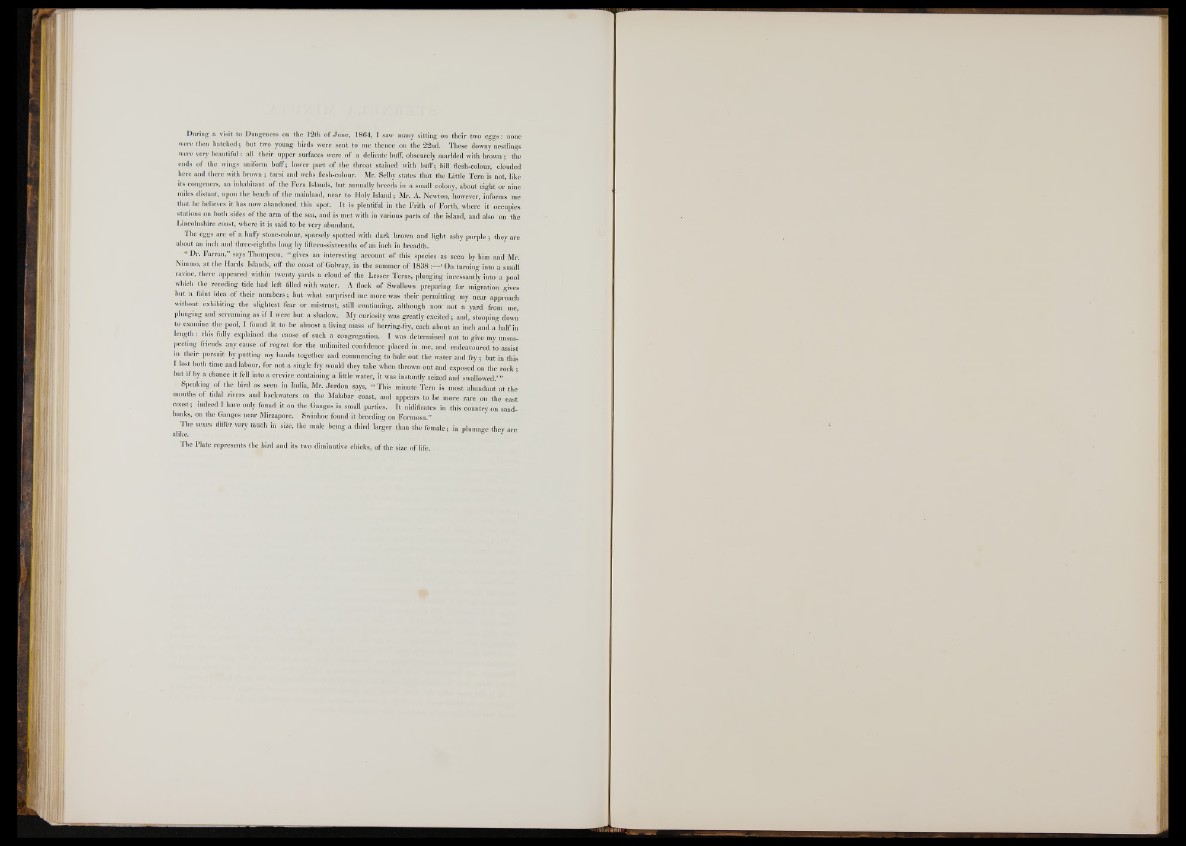
During a visit to Dungcness on the 12th o f June, 1864, I saw many sitting on their two eggs: none
were then hatched; but two young birds were sent to me thence on the 22nd. These downy nestlings
were very beautiful: all their upper surfaces were o f a delicate buff, obscurely marbled with brown ; the
ends o f the wings uniform buff; lower part of the throat stained with buff; bill flesh-colour, clouded
here and there with brown ; tarsi and webs flesh-colour. Mr. Selby states that the Little Tern is not, like
its congeners, an inhabitant of the Fern Islands, but annually breeds in a small colony, about eight or nine
miles distant, upon the beach of the mainland, near to Holy Island; Mr. A. Newton, however, informs me
that he believes it has now abandoned this spot. It is plentiful in the Frith o f Forth, where it occupies
stations on both sides o f the arm o f the sea, and is met with in various parts of the island, and also on the
Lincolnshire coast, where it is said to be very abundant;
The eggs are of a buffy stone-colour, sparsely spotted with dark brown and light ashy purple; they are
about an inch and three-eighths long by fifteen-sixteenths o f an inch in breadth.
“ Dr. Farran,” says Thompson, “ gives an interesting account of this species as seen by him and Mr.
Nimrno, at the Hards Islands, off the coast o f Galway, in the summer o f 1 8 3 8 —‘On turning into a small
ravine, there appeared within twenty yards a cloud o f the Lesser Terns, plunging incessantly into a pool
which the receding tide had left filled with water. A flock o f Swallows preparing for migration gives
but a faint idea of their numbers; but what surprised me more was their permitting my near approach
without exhibiting the slightest fear or mistrust, still continuing, although now not a yard from me,
plunging and screaming as if I were but a shadow. My curiosity was greatly excited; and, stooping down
to examine the pool, I found it to be almost a living mass o f herring-fry, each about an inch and a half in
length : this fully explained the cause o f such a congregation. I was determined not to give my unsuspecting
friends any cause o f regret for the unlimited confidence placed in me, and endeavoured to assist
in their pursuit by putting my hands together and commencing to bale out the water and fry ; but in this
I lost both time and labour, for not a single fry would they take when thrown out and exposed on the rock ;
but if by a chance it fell into a crevice containing a little water, it was instantly seized and swallowed.’ ”
Speaking of the bird as seen in India, Mr. Jerdon says, “ This minute Tern is most abundant at the
mouths o f tidal rivers and backwaters on the Malabar coast, and appears to be more rare on the east
coast; indeed I have only found it on the Ganges in small parties. It nidificates in this country on sandbanks,
on the Ganges near Mirzapore. Swinhoe found it breeding on Formosa.”
The sexes differ very much in size, the male being a third larger than the female; in plumage they are
alike. 5 J
The Plate represents the bird and its two diminutive chicks, o f the size of life.